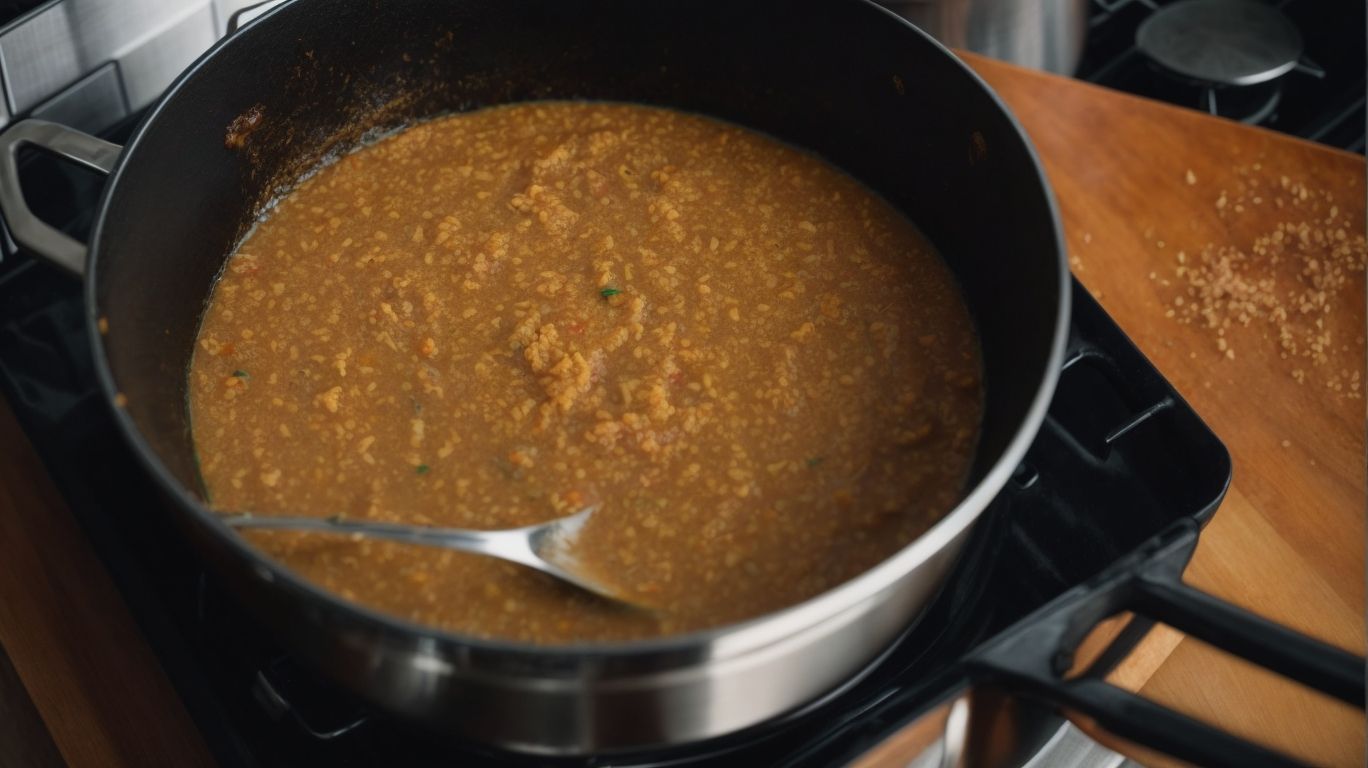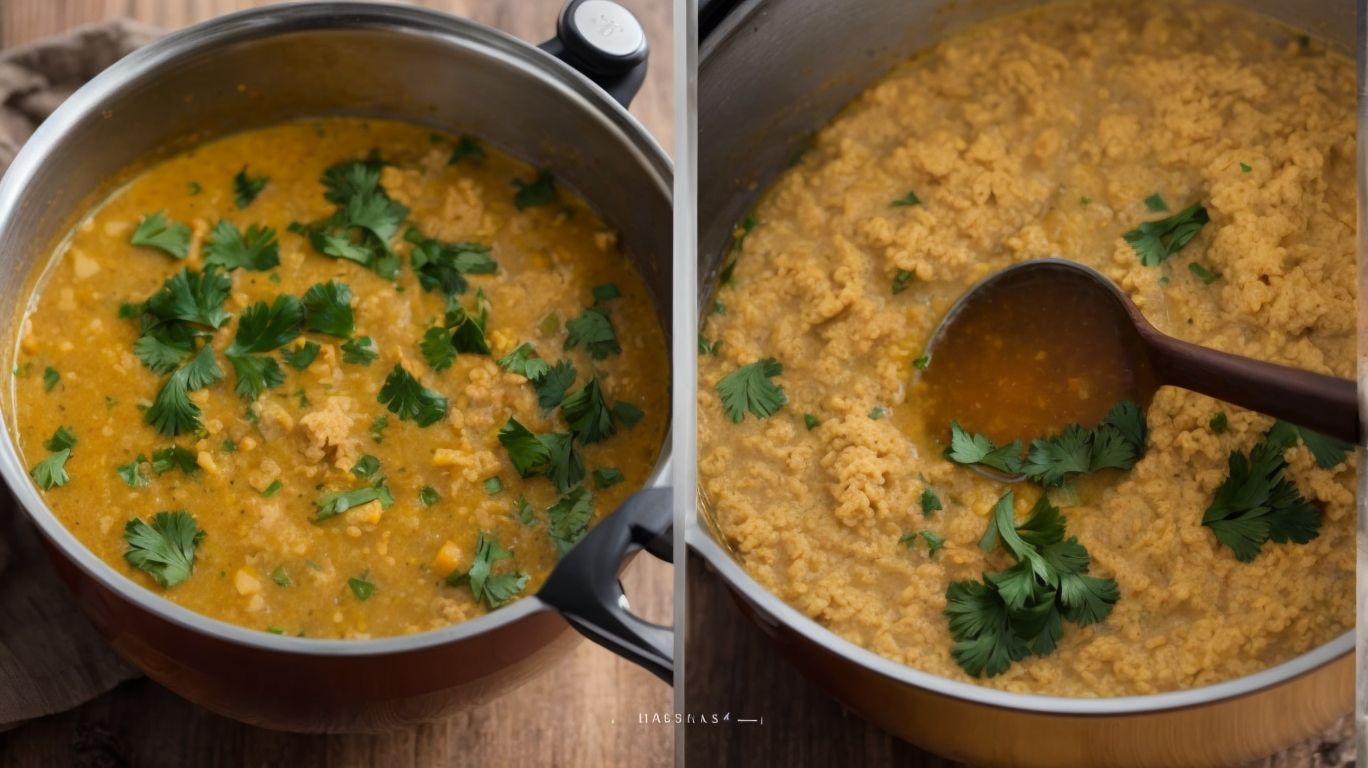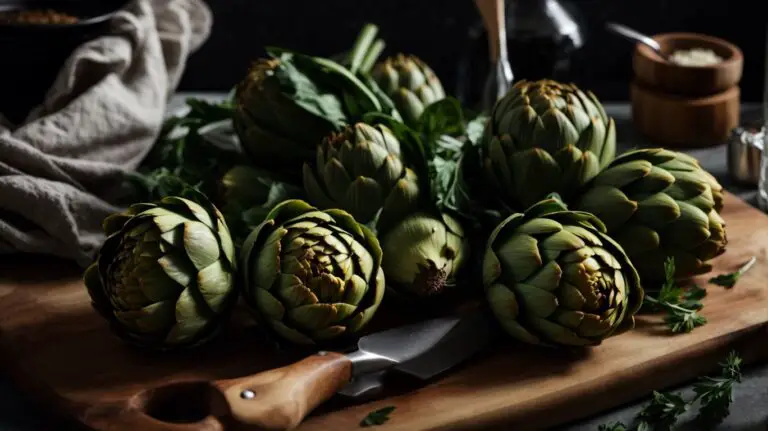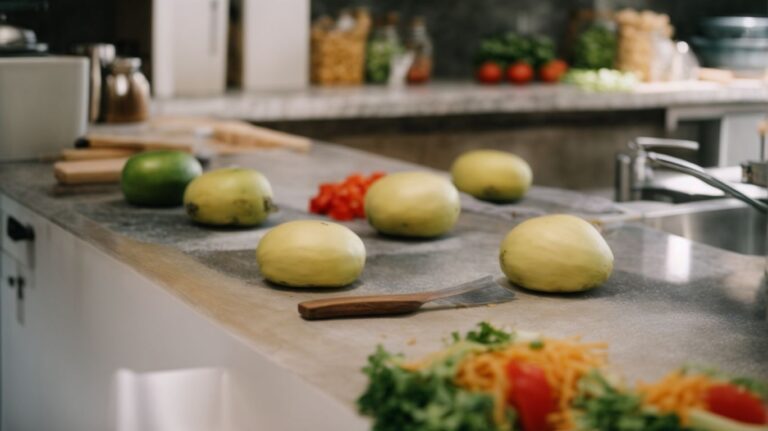How to Cook Egusi Soup by Boiling Method?
Craving a delicious and hearty bowl of Egusi Soup? Look no further!
We explore the boiling method of cooking Egusi Soup, from the essential ingredients needed to the various variations you can try. Follow our step-by-step guide to perfectly cook this African delicacy, including tips and tricks for making your Egusi Soup thicker and spicier.
Elevate your culinary skills and impress your taste buds with a bowl of flavorful Egusi Soup!
Key Takeaways:
What is the Boiling Method of Cooking Egusi Soup?
The boiling method of cooking Egusi Soup involves simmering a flavorful mixture of ground egusi seeds, vegetables, and meat in a cooking pot.
-
One of the key steps in preparing Egusi Soup using the boiling method is to start by heating some palm oil in the cooking pot until it’s hot. This helps to bring out the rich flavors of the ingredients.
-
Next, add chopped onions, peppers, and tomatoes to the hot oil, stirring occasionally until they are softened and fragrant. This forms the base of the soup and adds a lovely depth of flavor.
-
After the vegetables have cooked down, sprinkle in the ground egusi seeds and stir well to combine all the ingredients, creating a thick paste-like consistency.
What Are the Ingredients Needed for Boiling Method?
To prepare Egusi Soup using the boiling method, gather ingredients such as red palm oil, ground egusi seeds, assorted vegetables like ugu leaves, meats, seasonings such as pepper, salt, and stock cubes, and water for the base.
Red palm oil adds a distinct flavor and rich color to the Egusi Soup. Ground egusi seeds act as a thickening agent, giving the soup a creamy texture. Assorted vegetables like ugu leaves not only bring a pop of color but also provide essential nutrients. Meats, such as beef or fish, contribute protein and depth of flavor. Seasonings like pepper, salt, and stock cubes enhance the taste profile of the dish. Water serves as the base for the soup, allowing all the ingredients to meld together beautifully.
What Are the Different Variations of Boiling Method?
There are various interpretations and regional twists to the boiling method of preparing Egusi Soup, reflecting the diverse culinary influences and preferences within Nigerian cuisine.
For instance, in the southwestern region of Nigeria, the Yoruba people often enhance their Egusi Soup with palm oil and bitter leaf, creating a rich and slightly bitter flavor profile. Contrastingly, in the eastern part of the country, the Igbo community prefers adding uziza leaves and a mix of protein such as stockfish and cow tripe to deepen the umami taste of the soup.
Step-by-Step Guide to Cooking Egusi Soup by Boiling Method
Follow this comprehensive guide to prepare delicious Egusi Soup using the boiling method, starting with the preparation of a flavorful paste and ending with a hearty simmer in a cooking pot.
To kick off your Egusi Soup journey, begin by selecting the freshest ingredients. You’ll need ground melon seeds, assorted meats like beef, stockfish, and cow tripe, as well as palm oil for that authentic flavor.
Next, chop your vegetables, including spinach and bitterleaf, ready to add a burst of color and nutrients to your dish. Mix your ground Egusi seeds with water to form a smooth paste, then set it aside.
Place your cooking pot on the stove, pour in some palm oil, and allow it to heat up before adding your sliced onions and crayfish. Stir until fragrant, then introduce your Egusi paste, allowing it to cook until it thickens and the oil starts to separate.
Now, it’s time for the star of the show – add your protein medley and vegetables, stirring gently to combine all the flavors. Let it simmer on low heat until everything is tender and infused with the rich Egusi goodness.
Serve piping hot with a side of fluffy pounded yam or steamed rice for a truly satisfying meal.
Step 1: Prep the Ingredients
Begin the Egusi Soup preparation by gathering and preparing the essential ingredients, including ground egusi seeds, crayfish, Maggi cubes, and other seasonings required to infuse flavor into the soup.
Quality ingredients are paramount when it comes to creating a stellar Egusi Soup. It’s crucial to source fresh and authentic ground egusi seeds, as they are the star of this dish, imparting a rich and nutty flavor. The crayfish, with its unique briny essence, adds depth to the soup, while the Maggi cubes provide that savory umami kick that elevates the overall taste. Don’t forget to season with salt, pepper, and other spices to balance the flavors perfectly.
Proper seasoning is the secret to a mouthwatering Egusi Soup. The harmonious blend of these ingredients creates a symphony of flavors that will tantalize your taste buds and transport you to the heart of West African cuisine. Take the time to select high-quality ingredients, for they are the building blocks of a truly delicious and authentic Egusi Soup.
Step 2: Boil the Meat and Stockfish
Next, boil the cow meat and stockfish to tender perfection, ensuring that the meat flavors the broth and enriches the base of the Egusi Soup.
When cooking the cow meat, it’s crucial to simmer it over low heat, allowing the flavors to meld and the meat to become irresistibly tender. This slow cooking process not only infuses the broth with a depth of meaty goodness but also helps break down tough fibers for a melt-in-your-mouth texture.
Stockfish, on the other hand, brings a unique umami richness to the soup. To achieve optimal results, soak the stockfish overnight to soften it and remove excess salt. Boiling it gently ensures that it imparts its distinctive flavor without overpowering the other ingredients.
Step 3: Blend the Egusi Seeds
Blend the ground egusi seeds into a smooth paste, incorporating palm oil to create a rich and aromatic base for the Egusi Soup.
Ensuring that the paste reaches a velvety texture is crucial in achieving the authentic taste that characterizes this traditional African dish. The combination of the earthy notes from the egusi seeds and the lusciousness of the palm oil forms the heart of the soup, infusing it with a deep and savory flavor profile.
Consistency plays a key role; you want the paste to be thick enough to hold its shape yet still spreadable for even distribution of flavors. This method allows the ingredients to meld together harmoniously, resulting in a satisfying and hearty meal.
Step 4: Cook the Egusi Mixture
Cook the blended egusi mixture in a pot, allowing it to simmer and thicken to create a luscious base similar to the consistency of groundnut soup.
When you’re simmering the egusi mixture, it’s crucial to keep an eye on it to prevent burning and to enhance its nutty aroma. Stir occasionally to ensure even cooking and the development of flavors. You’ll notice that as it cooks down, the egusi mixture transforms into a creamy texture, mirroring the richness found in traditional nut-based dishes.
Just like with groundnut soup, the longer you let it simmer, the deeper and more complex the flavors will become. This slow-cooking process allows the nutty undertones to shine through, creating a truly indulgent experience for your taste buds.
Step 5: Add the Meat and Stockfish
Incorporate the boiled meat and stockfish into the simmering egusi soup, allowing the flavors to meld and infuse the soup with savory richness.
By adding the pre-boiled meat and stockfish at this stage, you are not only enhancing the depth of flavor but also ensuring that the proteins are well integrated into the dish. The slow simmering process allows the ingredients to intermingle, creating a harmonious blend that tantalizes the taste buds. This infusion of flavors is crucial in soup-making as it elevates the overall profile of the dish, making it more satisfying and flavorful.
Step 6: Add Other Ingredients
Introduce additional ingredients such as ugu leaves and preferred seasonings to the Egusi Soup, enhancing the dish with vibrant colors and fresh flavors.
Regarding incorporating ugu leaves, also known as fluted pumpkin leaves, into the Egusi Soup, you’re not just adding a pop of color but also a powerhouse of nutrients. These dark green leaves are rich in vitamins A, C, and E, along with essential minerals like iron and potassium.
To really elevate the visual appeal, consider garnishing the soup with finely chopped coriander leaves or sprinkling some toasted sesame seeds on top. This added touch not only enhances the presentation but also introduces a subtle nutty flavor profile to the dish.
Step 7: Let it Simmer and Serve
Allow the Egusi Soup to simmer gently, allowing the flavors to meld and intensify before serving it piping hot alongside a side of fufu or ewedu soup.
As the Egusi Soup simmers, the aroma fills the kitchen, tantalizing the taste buds with its rich and hearty essence. The key to achieving that perfect consistency lies in stirring occasionally and checking the seasoning to ensure a well-balanced flavor profile. Patience is essential at this stage as the magic of slowly cooked ingredients transforms into a harmonious symphony of taste.
Once the soup reaches its peak flavor, it’s time to plate up. Ladle the creamy Egusi Soup into bowls, garnishing with a sprinkle of chopped fresh herbs or a drizzle of palm oil for that extra touch of authenticity. Pair it with a mound of fluffy fufu, its soft texture and neutral taste the ideal complement to the bold flavors of the soup. And don’t forget a side of ewedu soup, its slimy consistency contrasting beautifully with the thick Egusi base.
Tips and Tricks for Perfect Egusi Soup

Credits: Poormet.Com – Elijah Hall
Enhance the thickness of your Egusi Soup by adjusting the ratio of egusi paste to broth, or spice it up to your liking with extra pepper or chili for a spicier kick.
If you prefer a thicker consistency in your Egusi Soup, consider adding palm oil during the cooking process as it not only enhances the richness but also contributes to a thicker texture. Alternatively, you can blend some cooked yam or plantains and incorporate it into the soup to naturally thicken it without altering the flavor profile significantly.
Regarding spices, experimenting with locally sourced ingredients like uziza leaves or scent leaves can add a unique dimension to the flavor profile. Don’t be afraid to play around with different spice blends such as ginger, garlic, and onion powders to tailor the taste to your preference.
How to Make Egusi Soup Thicker?
To make your Egusi Soup thicker, consider adjusting the amount of egusi paste used during preparation and allowing the mixture to simmer longer to achieve desired consistency.
-
If you find that your Egusi Soup is still too runny after adjusting the egusi paste amount, you can also try incorporating additional thickening agents such as ground crayfish or ground melon seeds. These ingredients not only enhance the flavor but also contribute to the overall thickness of the soup.
-
Another trick to achieve a thicker consistency is to blend some of the cooked Egusi Soup mixture and then reincorporate it back into the pot. This method helps to create a smooth, velvety texture while naturally thickening the soup.
How to Make Egusi Soup Spicier?
For a spicier kick in your Egusi Soup, increase the amount of pepper or chili flakes during the cooking process, ensuring to balance the heat with salt for a harmonious flavor profile.
Another way to enhance the spiciness of your Egusi Soup is by incorporating fresh hot peppers like scotch bonnet or habanero peppers for an added burst of heat.
Experimenting with different types of chili powders, such as cayenne or smoked paprika, can also bring a unique depth of flavor to your dish.
Remember, when adjusting the spice level, it’s essential to taste as you go and gradually add pepper or chili to achieve the desired heat intensity without overpowering the other flavors.
Conclusion

Credits: Poormet.Com – Nathan Robinson
Mastering the art of cooking Egusi Soup using the boiling method opens up a world of flavorful possibilities, allowing you to experiment with ingredients and techniques to suit your personal preferences and culinary influences.
Whether you prefer a thicker consistency by adjusting the amount of water or enjoy a spicier kick by adding more habanero peppers, Egusi Soup is a canvas for your culinary creativity. You can elevate the dish’s richness with an extra scoop of ground crayfish or explore a vegetarian twist by omitting the protein. Embrace the subtleties of flavor by balancing the nuttiness of egusi seeds with the tang of fresh tomatoes, offering a harmonious blend of tastes and textures that cater to your unique palate.
Frequently Asked Questions
What ingredients do I need to cook Egusi Soup using the boiling method?
To cook Egusi Soup by boiling method, you will need ground egusi (melon) seeds, meats or fish, palm oil, onions, tomatoes, peppers, and various traditional spices and seasonings.
Can I use frozen Egusi to make the soup?
Yes, you can use frozen egusi, but make sure to thaw it completely before cooking. Frozen egusi may alter the consistency of the soup, so adjust the amount of water accordingly.
How long will it take to cook Egusi Soup using the boiling method?
It typically takes about 30-40 minutes to cook Egusi Soup using the boiling method. However, the cooking time may vary depending on the type and quantity of ingredients used.
Can I substitute palm oil with another type of oil?
While palm oil is traditionally used in Egusi Soup, you can substitute it with other oils like vegetable oil or olive oil. However, keep in mind that the flavor and color may be slightly different.
Do I need to pre-cook the meats before adding them to the soup?
Yes, it is recommended to pre-cook the meats before adding them to the soup. This will ensure that the meats are fully cooked and tender before adding them to the boiling soup.
Can I add vegetables to the Egusi Soup?
Yes, you can add vegetables like spinach, pumpkin leaves, or bitter leaves to the Egusi Soup. Make sure to add them towards the end of cooking to prevent them from overcooking.





